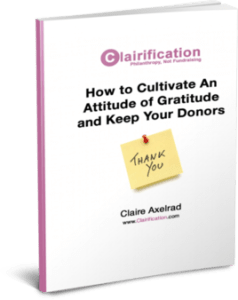
Awareness alone is passive
I wish I had a dime for every time a nonprofit board or staff member told me “We’re the best kept secret in town; if people knew what we do, they’d give to support us.”
If I had all those dimes, I could make a nice contribution to your cause. That is, if…
- You endeavored to learn a little bit about me,
- You engaged me personally,
- Then you asked me.
You see, merely “building awareness” will not ipso facto raise more money for your cause.
Just because I care about something, and somehow learn you are involved in doing something about that thing, doesn’t mean I’m going to support you financially.
Why should I? There are a lot of good causes out there, and making a decision to invest in you is something I need to act on.
I’m busy. I’m overloaded with information. And inertia is just too powerful a force.
Something more than awareness is needed to secure a donor.
In It’s All About the Donor on Nonprofit Pro, Katrina Van Huss and Otis Fulton artfully explain why.
It is hard to bring new blood into the fold just by spreading the word. You can give people all the reasons that your cause is worthwhile and chronicle all the progress you make and lives you touch, and yet, most decline to make a gift… Do we have a better acquisition technique than “create brand awareness and ask for money?” We do. We use other devices to gain the first interaction.
Why can’t the marketing and branding folks simply do their thing and make donors magically appear? Why can’t you just slap a “donate” button on your website and see gifts come flowing in?
Why are “other devices” essential?
Knowing about something and doing something about it are two different things.
No matter how much your marketing messages may resonate, most folks are going to remain bystanders.
You have to get to the engagement if you want to get to the marriage.
Something more than mere knowledge or liking is needed to secure a donor. And keep them.
Donors need to have some skin in the game before they’re likely to really want to start playing your game. You know, the game where you move the ball down the field towards the goal.
Together. You with your donor.
As a team.
Donors need to feel a part of your team.
Donors need to have a more direct connection to you than simply reading about you on social media or receiving an appeal in the mail.
A “skin in the game” connection could mean:
- They or someone they know used your services.
- They have a friend who asks them to give.
- They volunteered for you.
- They responded to a survey or advocacy alert.
- They attended an event.
When these connections haven’t already happened, it’s your job to make them happen!
The marketing continuum usually moves from awareness… to interest… to engagement… to investment.
Your job is to move donors from awareness to engagement.
I worked on staff for nonprofits for over 30 years, and one of the most important things I did was find and create engagement opportunities to connect donors personally with our mission.
Sometimes it was challenging. Events and volunteer opportunities could be scarce, and program staff weren’t always cooperative.
They didn’t necessarily see the value of creating a new event or volunteer opportunity primarily for the sake of “drawing donors closer” to the mission. You see, they didn’t see donors as part of the mission. They saw them more as servants. Not in a bad way, of course. They agreed donors were serving a noble purpose. But… they were servants nonetheless. Not equal partners.
It was understandable that program staff weren’t all that excited about taking time out of their busy day to take donors behind the scenes. Especially with a “donor as servant” mentality. Why should they serve the servants?
I say this not to cast aspersions on program staff, but to bring to light a common perception. Or perhaps it’s a divide, or just a simple misconception of the role of philanthropy within a nonprofit.
It takes a village to generate and sustain philanthropic investment.
It is incumbent on executive and development leaders to move their organizations towards a culture of philanthropy.
A culture that embraces “love of humankind” and turns that love back towards donors. A culture where donors are at the heart of the mission.
As the founder of The Fundraising School, and one of my mentors, famously said:
Fundraising is servant to philanthropy. – Hank Rosso
In other words, fundraising is never an end in itself. It’s a practice; how we meet the goal. It draws meaning from philanthropic ends served.
Engagement opportunities bridge the gap between spreading the word and philanthropy.
Getting donors on your team requires an invitation to participate in some sort of activity that includes them in your mission.
I call these activities ‘engagement opportunities.’ Better than anything else I know, they move people to higher levels of involvement and investment.
They can be real (e.g., events, volunteer activities) or virtual (e.g., surveys to take, petitions to sign, games to play), but there’s little doubt in my mind that engagement experiences offer your best bet for bringing, and keeping, folks on board.
After their first or second interaction, folks will be much more receptive to an ask for financial support.
Getting practical, this means your organization—and everyone in it—must understand that philanthropy doesn’t much happen without fundraising ambassadors, advocates and askers.
It goes beyond marketing communications and awareness building.
Fundraising is a hands-on team sport.
Everyone in the organization is on the team. No one sits on the sidelines.
And I’ll tell you that, in my experience, volunteer and program staff who are involved in these hands-on opportunities to draw donors closer to the mission do begin to see the benefits.
In fact, it doesn’t take long. Because once they get up close and personal with your supporters, staff see that “donors” are much like them – people who care about creating positive change.
But…
I know. Some of you are fighting with me in your minds. You work for some of the large philanthropies who are benefiting from the current activist zeitgeist. Maybe the ACLU, Planned Parenthood or Southern Poverty Law Center? And you’re finding folks are donating online even without all this engagement. The ACLU raised $85 million online last year, in a time period they usually raise about $5 million.
Okay, fine. Sometimes people give without being actively inspired and engaged. Without being wooed, and asked, and wooed some more. People respond to true emergencies.
But one-time gifts do not long-term engagers or investors make.
You still need engagement opportunities.
Just maybe more after the fact.
In a Huffington Post piece, Giving In The Age of Outrage, Steve MacLauglin, VP of Data and Analytics at Blackbaud, makes the case that more activists are giving online today simply in response to hearing about a cause. In fact, they’ve been doing so in response to emergencies ever since the advent of the Internet and, especially, the explosion of social media.
But MacLaughlin also warns:
“It cannot be stressed enough that these new donors need to be kept engaged, stewarded, and shown the impact of their gifts. Historical data shows that episodic donors are a challenge for nonprofits to retain for more than few years. Talk to anyone who has worked with these donors and they will tell you that there is a ticking clock from the moment that gift is made.”
Engagement opportunities boost both first-time gifts and renewals.
Whether you’re transforming passive awareness into giving, or one-time transactional responses into ongoing giving, the critical driver of commitment and loyalty is ongoing engagement.
Your active investment in, and follow up with, your donors will mean the difference between so-so results and stellar ones.
Your job is to facilitate philanthropy. Don’t expect it to happen on its own.
If you facilitate it, they will come.
To your success!
Want to Boost Donor Engagement?
 Check out my e-guide: How To Cultivate An Attitude Of Gratitude And Keep Your Donors. It’s chock full of info on the theory and practice of gratitude, and something you’ll find useful no matter your job title. I share with you tons of tips, templates, checklists and samples to help you apply what you learn. As with all Clairification products, you receive a generous discount if you’re an enrolled Clairification School student and there’s a 30-day, no-questions-asked, money-back guarantee!
Check out my e-guide: How To Cultivate An Attitude Of Gratitude And Keep Your Donors. It’s chock full of info on the theory and practice of gratitude, and something you’ll find useful no matter your job title. I share with you tons of tips, templates, checklists and samples to help you apply what you learn. As with all Clairification products, you receive a generous discount if you’re an enrolled Clairification School student and there’s a 30-day, no-questions-asked, money-back guarantee!
Photo by Clarisse Meyer on Unsplash.





Can I share this on LinkedIn and Facebook?
Of course Jen!
Please look at the Donor Experience Project’s work here. What you have said in this blog resonates so much with what we are trying to achieve here in the UK. I think you’ll love it.
I do love it!